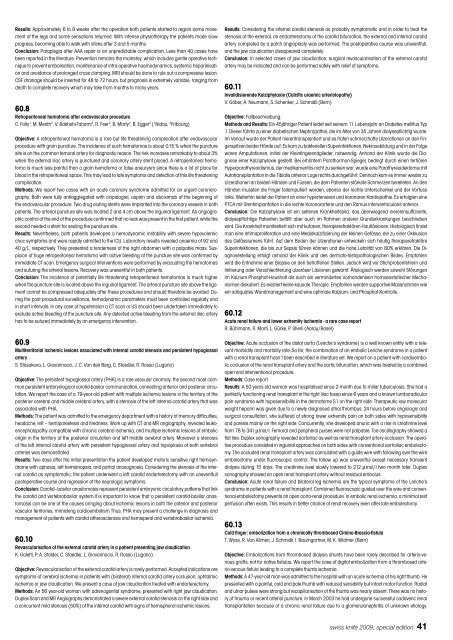Abstracts - Chirurgie Kongress
Abstracts - Chirurgie Kongress
Abstracts - Chirurgie Kongress
Create successful ePaper yourself
Turn your PDF publications into a flip-book with our unique Google optimized e-Paper software.
Results: Approximately 6 to 8 weeks after the operation both patients started to regain some movement<br />
of the legs and some sensations returned. With intense physiotherapy the patients made slow<br />
progress, becoming able to walk with sticks after 3 and 5 months<br />
Conclusion: Paraplegia after AAA repair is an unpredictable complication. Less than 40 cases have<br />
been reported in the literature. Prevention remains the mainstay, which includes gentle operative technique<br />
to prevent embolisation, maintenance of intra-operative haemodynamics, systemic heparinisation<br />
and avoidance of prolonged cross clamping. MRI should be done to rule out a compressive lesion.<br />
CSF drainage should be inserted for 48 to 72 hours, but prognosis is extremely variable, ranging from<br />
death to complete recovery which may take from months to many years.<br />
60.8<br />
Retroperitoneal hematoma after endovascular procedure<br />
C. Folly 1 , M. Menth 2 , V. Bakhshi-Tahami 2 , R. Feer 2 , B. Marty 2 , B. Egger 2 ( 1 Nidau, 2 Fribourg)<br />
Objective: A retroperitoneal hematoma is a rare but life threatening complication after endovascular<br />
procedure with groin puncture. The incidence of such hematomas is about 0.15 % when the puncture<br />
site is on the common femoral artery for diagnostic reason. The risk increases remarkably to about 3%<br />
when the external iliac artery is punctured and coronary artery stent placed. A retroperitoneal hematoma<br />
is much less painful than a groin hematoma or false aneurysm since there is a lot of place for<br />
blood in the retroperitoneal space. This may lead to late symptoms and detection of this life threatening<br />
complication.<br />
Methods: We report two cases with an acute coronary syndrome admitted for an urgent coronarography.<br />
Both were fully antiaggregated with clopidogrel, aspirin and abciximab at the beginning of<br />
the endovascular procedure. Two drug eluting stents were implanted into the coronary vessels in both<br />
patients. The arterial puncture site was located 2 and 4 cm above the inguinal ligament. An angiographic<br />
control at the end of the procedure confirmed that no leak was present in the first patient, while the<br />
second needed a stent for sealing the puncture site.<br />
Results: Nevertheless, both patients developed a hemodynamic instability with severe hypovolemic<br />
choc symptoms and were rapidly admitted to the ICU. Laboratory results revealed anaemia of 92 and<br />
40 g/L, respectively. They presented a tenderness of the right abdomen with a palpable mass. Suspicion<br />
of huge retroperitoneal hematoma with active bleeding at the puncture site was confirmed by<br />
immediate CT-scan. Emergency surgical interventions were performed by evacuating the hematomas<br />
and suturing the arterial lesions. Recovery was uneventful in both patients.<br />
Conclusion: The incidence of potentially life threatening retroperitoneal hematomas is much higher<br />
when the puncture site is located above the inguinal ligament. The arterial puncture site above the ligament<br />
cannot be compressed adequately after these procedures and should therefore be avoided. During<br />
the post procedural surveillance, hemodynamic parameters must been controlled regularly and<br />
in short intervals. In any case of hypotension a CT scan or US should been undertaken immediately to<br />
exclude active bleeding at the puncture site. Any detected active bleeding from the external iliac artery<br />
has to be sutured immediately by an emergency intervention.<br />
60.9<br />
Multiterritorial ischemic lesions associated with internal carotid stenosis and persistent hypoglossal<br />
artery<br />
S. Stasakova, L. Giovannacci, J. C. Van den Berg, C. Staedler, R. Rosso (Lugano)<br />
Objective: The persistent hypoglossal artery (PHA) is a rare vascular anomaly, the second most common<br />
persistent embryological carotid-basilar communication, connecting anterior and posterior circulation.<br />
We report the case of a 79-year old patient with multiple ischemic lesions in the territory of the<br />
posterior cerebral and middle cerebral artery, with a stenosis of the left internal carotid artery that was<br />
associated with PHA.<br />
Methods: The patient was admitted to the emergency department with a history of memory difficulties,<br />
headache, left – hemiparestesis and tiredness. Work up with CT and MR angiography, revealed leukoencephalopathy<br />
compatible with chronic cerebral ischemia, and multiple ischemic lesions of embolic<br />
origin in the territory of the posterior circulation and left middle cerebral artery. Moreover a stenosis<br />
of the left internal carotid artery with persistent hypoglossal artery and hypoplasia of both vertebral<br />
arteries was demonstrated.<br />
Results: Two days after the initial presentation the patient developed motoric sensitive right hemisyndrome<br />
with aphasia, left hemianopsia, and partial anosognosia. Considering the stenosis of the internal<br />
carotid as symptomatic, the patient underwent a left carotid endarterectomy with an uneventfull<br />
postoperative course and regression of the neurologic symptoms.<br />
Conclusion: Carotid–basilar anastomosis represent persistent embryonic circulatory patterns that link<br />
the carotid and vertebrobasilar system.It is important to know that a persistent carotid-basilar anastomosis<br />
can be one of the causes bringing about ischemic lesions in both the anterior and posterior<br />
vascular territories, mimicking cardioembolism Thus, PHA may present a challenge in diagnosis and<br />
management of patients with carotid atherosclerosis and hemisperal and vertebrobasilar ischemia.<br />
60.10<br />
Revascularisation of the external carotid artery in a patient presenting jaw claudication<br />
K. Galetti, P. A. Stalder, C. Staedler, L. Giovannacci, R. Rosso (Lugano)<br />
Objective: Revascularisation of the external carotid artery is rarely performed. Accepted indications are<br />
symptoms of cerebral ischemia in patients with (bilateral) internal carotid artery occlusion, ophtalmic<br />
ischemia or jaw claudication. We present a case of jaw claudication treated with endarterectomy.<br />
Methods: An 56 year-old woman with adrenogenital syndrome, presented with right jaw claudication.<br />
Duplex Scan and MR Angiography demonstrated a severe external carotid stenosis on the right side and<br />
a concurrent mild stenosis (50%) of the internal carotid with signs of hemispheral ischemic lesions.<br />
Results: Considering the internal carotid stenosis as probably symptomatic and in order to treat the<br />
stenosis of the external, an endarterectomy of the carotid bifurcation, the external and internal carotid<br />
artery completed by a patch angioplasty was performed. The postoperative course was uneventfull,<br />
and the jaw claudication disappeared completely.<br />
Conclusion: In selected cases of jaw claudication, surgical revascularisation of the external carotid<br />
artery may be indicated and can be performed safely with relief of symptoms.<br />
60.11<br />
Invalidisierende Kalziphylaxie (Calcific uraemic arteriolopathy)<br />
V. Göber, A. Neumann, S. Schenker, J. Schmidli (Bern)<br />
Objective: Fallbeschreibung.<br />
Methods and Results: Ein 45jähriger Patient leidet seit seinem 11. Lebensjahr an Diabetes mellitus Typ<br />
1. Dieser führte zu einer diabetischen Nephropathie, die im Alter von 35 Jahren dialysepflichtig wurde.<br />
Im Verlauf wurde der Patient nierentransplantiert und es traten schmerzhafte Ulzerationen an den Fingerspitzen<br />
beider Hände auf. Es kam zu bakteriellen Superinfektionen, Nekrosebildung und in der Folge<br />
waren Amputationen, initial der Kleinfingerendglieder, notwendig. Anhand der Klinik wurde die Diagnose<br />
einer Kalziphylaxie gestellt. Bei erhöhtem Parathormon-Spiegel, bedingt durch einen tertiären<br />
Hyperparathyreoidismus, der medikamentös nicht zu senken war, wurde eine Parathyreoidektomie mit<br />
Autotransplantation in die Tibialis anterior Loge rechts durchgeführt. Dennoch kam es immer wieder zu<br />
Ulzerationen an beiden Händen und Füssen, die dem Patienten stärkste Schmerzen bereiteten. An den<br />
Händen mussten die Finger teilamputiert werden, ebenso der rechte Unterschenkel und der Vorfuss<br />
links. Weiterhin leidet der Patient an einer hypertensiven und koronaren Kardiopathie. Es erfolgten eine<br />
PTCA mit Stentimplantation in die rechte Koronararterie und den Ramus interventricularis anterior.<br />
Conclusion: Die Kalziphylaxie ist ein seltenes Krankheitsbild, das überwiegend niereninsuffiziente,<br />
dialysepflichtige Patienten befällt aber auch im Rahmen anderer Grunderkrankungen beschrieben<br />
wird. Die Krankheit manifestiert sich mit kutanen, therapierefraktären Hautläsionen. Histologisch findet<br />
man eine Intimaproliferation und eine Mediakalzifizierung der kleinen Gefässe, die zu einer Okklusion<br />
des Gefässlumens führt. Auf dem Boden der Ulzerationen entwickeln sich häufig therapierefraktäre<br />
Superinfektionen, die bis zur Sepsis führen können und die hohe Letalität von 80% erklären. Die Diagnosestellung<br />
erfolgt anhand der Klinik und des dermato-histopathologischen Bildes. Empfohlen<br />
wird die Entnahme einer Biopsie an den betroffenen Stellen. Jedoch wird vor Stichprobenfehlern und<br />
Initiierung oder Verschlechterung ulzeröser Läsionen gewarnt. Ätiologisch werden sowohl Störungen<br />
im Kalzium-Phosphat-Haushalt als auch ein vermindertes Vorhandensein homoeostatischer Mechanismen<br />
diskutiert. Es existiert keine kausale Therapie. Empfohlen werden supportive Massnahmen wie<br />
ein adäquates Wundmanagement und eine optimale Kalzium- und Phosphat-Kontrolle.<br />
60.12<br />
Acute renal failure and lower extremity ischemia - a rare case report<br />
R. Bühlmann, R. Marti, L. Gürke, P. Stierli (Aarau/Basel)<br />
Objective: Acute occlusion of the distal aorta (Leriche’s syndrome) is a well known entity with a relevant<br />
morbidity and mortality rate. So far, the combination of an embolic Leriche syndrome in a patient<br />
with a renal transplant hasn’t been described in literature yet. We report on a patient with cardioembolic<br />
occlusion of the renal transplant artery and the aortic bifurcation, which was treated by a combined<br />
open and interventional procedure.<br />
Methods: Case report<br />
Results: A 50 years old woman was hospitalised since 2 month due to miliar tuberculosis. She had a<br />
perfectly functioning renal transplant in the right iliac fossa since 6 years and a known lumboradicular<br />
pain syndrome with hyposensibility in the dermatome S1 on the right side. Therapeutic low molecular<br />
weight heparin was given due to a newly diagnosed atrial thrombus. 24 hours before angiologic and<br />
surgical consultation, she suffered of strong lower extremity pain on both sides with hyposensibility<br />
and paresis mainly on the right side. Concurrently, she developed anuria with a rise in creatinine level<br />
from 78 to 341 µmol/l. Femoral and peripheral pulses were not palpable. Toe oscillography showed a<br />
flat line. Duplex sonography revealed aortoiliac as well as renal transplant artery occlusion. The operative<br />
procedure consisted in inguinal approaches on both sides with conventional aortoiliac embolectomy.<br />
The occluded renal transplant artery was cannulated with a guide wire with following over the wire<br />
embolectomy under fluoroscopic control. The follow up was uneventful except necessary transient<br />
dialysis during 15 days. The creatinine level slowly lowered to 212 µmol/l two month later. Duplex<br />
sonography showed an open renal transplant artery without residual embolus.<br />
Conclusion: Acute renal failure and bilateral leg ischemia are the typical symptoms of the Leriche’s<br />
syndrome in patients with a renal transplant. Combined fluoroscopic guided over the wire and conventional<br />
embolectomy prevents an open aorto-renal procedure. In embolic renal ischemia, a minimal rest<br />
perfusion often exists. This results in better chance of renal recovery even after late embolectomy.<br />
60.13<br />
Cold finger: embolization from a chronically thrombosed Cimino-Brescia-fistula<br />
T. Wyss, R. Von Allmen, J. Schmidli, I. Baumgartner, M. K. Widmer (Bern)<br />
Objective: Embolizations from thrombosed dialysis shunts have been rarely described for arterio-venous<br />
grafts, not for native fistulas. We report the case of digital embolization from a thrombosed arterio-venous<br />
fistula leading to a complete thumb ischemia.<br />
Methods: A 47-year-old man was admitted to the hospital with an acute ischemia of his right thumb. He<br />
presented with a painful, cold and pale thumb with reduced sensibility but intact motor function. Radial<br />
and ulnar pulses were strong but recapillarisation of the thumb was nearly absent. There was no history<br />
of trauma or recent arterial puncture. In March 2003 he had undergone successful cadaveric renal<br />
transplantation because of a chronic renal failure due to a glomerulonephritis of unknown etiology.<br />
swiss knife 2009; special edition 41



